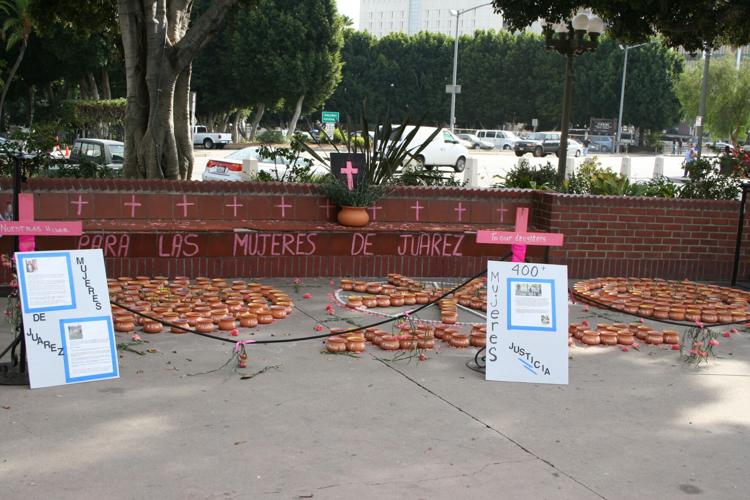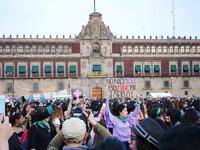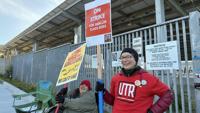
Pink crosses and candles lit for Day of the Dead in Placita Olvera honoring the victims of femicide in Ciudad Juarez. (Wikimedia Commons)
As thousands of women in the city of Los Angeles chanted with their strong voices and hand-drawn posters on March 8, also known as International Women’s Day, there was a common buzz felt in solidarity amongst the sea of the crowd celebrating how far women have come to make an impact in our society.
And yet, they are all also awareness of the struggles and adversity that has been built against them in their fight for a seat at the table for generations.
They marched for gender equality, as well as the protection of immigrants and transgender people in response to proposed policies by President Donald Trump. This struggle is magnified in marginalized communities: women of color, LGBTQ+, people with disabilities, immigrants and those of lower-economic status and poverty.
But ultimately, this intersectionality is what diversifies and unifies the community so much more today.
International Women’s Day is dedicated to celebrating the women in our lives from all walks of life and their role in the lives of not just our families, but also in media, music, representation and power against prejudice. It’s considered a happy day for women that transcends all borders to a euphoria of celebration worldwide, which also uses it as a platform for a call for action.
But for Mexico, this euphoria runs short.

International Women’s Day march in Mexico City. (Wikimedia Commons)
Instead of marching the streets in celebration, the air is bittersweet and the chants are of anger and frustration.
“¡Ni una más!¡Ni una menos!” (Not one more! not one less!)
“No somos una, no somos diez! ¡Somos un chingo, cuéntanos bien!”(We’re not one, we’re not 10, we’re a sh**load, count us right!)
“¡Vivas se las llevaron!”(They took them alive!)
While Mexico has transformed in social, political and economic ways, femicide is still an issue. A femicide, or feminicide, is the gender-based violence and murder of a woman, typically by a man.
According to data from Mexico’s National Institute of Statistics and Geography (INEGI), from 1990 to 2015, there was an annual average of 1,681 female homicide victims in Mexico. This number doubled significantly from 2016 to 2020 averaging at around 3,568 female homicide victims annually.
In Ciudad Juárez, a border city in the northern Mexican state of Chihuahua, more than 500 women were killed between 1993 and 2011 Along with contributing additional factors, it was named the most dangerous city in the world in 2010.
One of those cases was the disappearance of 14-year-old Esmeralda Castillo Rincon, who disappeared on May 19, 2009 in Juárez. Her father, José Luis Castillo Carreón, is known in the community for his endless dedication to seeking justice for his daughter and was seen at the Women’s March in the streets of Juárez on March 8.

Banner in Ciudad Juarez in light of the disappearance of Esmeralda Castillo Rincon. (Wikimedia Commons)
But that’s just one case. Esmeralda’s disappearance is one of many cases of femicide in Mexico that go unsolved.
Dr. Dario Valles, assistant professor of Chicana/o and Latina/o Studies at California State University, Long Beach, explains how femicides started as crimes of opportunity due to the higher visibility of women, especially in border towns like Juárez towards the latter end of the 20th century.
“Women in Mexico began to experience a transformation as Mexico began to modernize and industrialize its economy,” Valles said. “This transformation happened to coincide with women’s liberation movements as women’s movements from the U.S. and Europe spread to Latin America.”
Valles explains that women began to gain access to public and private sector employment outside of their homes, leading to more and more women leaving to work in cities and border towns. This included many who began working at the maquiladoras, giving these women hyper-visibility to the public and ultimately making them targets for the infamous femicides.
In many reports covering the disappearances and murders of these women, it was discovered that many of these people are migrants seeking asylum in the U.S. after making the journey from different parts of Mexico and Central America.
Valles references cases such as that of Angela Carolina Acosta Flores in Tijuana, a border town in Baja California, where men in the U.S. will travel to border towns with the purpose of murdering women, particularly targeting sex workers in the red light district.

Pink crosses in Lomas del Poleo Alta in Ciudad Juárez represented eight femicide victims in 1996. (Wikimedia Commons)
“There’s this sort of misogynist and racist assumption in the U.S. by a lot of men that you can go to Mexico and essentially get away with rape and even murder.” Valles said.
This exact irony and lack of protection for Mexican people, especially towards immigrants, is what has sparked outrage all across the U.S., including Los Angeles, which holds one of the largest populations of Latinos in the country with approximately 48.6% in 2024.
Last month, on February 2, thousands of Los Angeles natives protested in solidarity with Latinos in the community amid President Trump’s threat of mass deportations carried out by the U.S. Immigration and Customs Enforcement (ICE) recently as part of his Project 2025 campaign. But of course, the Trump administration’s threat of mass deportation in 2025 was not the sole reason for the outrage.
Thousands of banners were seen with phrases such as “Keep Families Together” and “Immigrants Make America Great”, outlining the outcries of the protesters in reference to the thousands of immigrants who have been separated and detained in detention facilities in the U.S., usually under inhumane conditions.
Under the Trump administration, immigrant detention peaked at around 55,654 people in August 2019, marking the highest level recorded. As of March 2025, over 46,000 immigrants remain in detention, despite facilities being designed for a maximum of 40,000, leading to severe overcrowding.
Amongst the sea of asylum seekers are many vulnerable women who fled their communities due to gender violence and are more at risk in these detention centers. Between 2012 and 2017, the number of migrant women apprehended in Mexico increased from 11,336 to 30,541, showcasing more women fleeing their home countries.
Now with Trump’s promise of mass deportations, women who once fled their communities to escape gender violence will be in a line of fire once again.

















(0) comments
Welcome to the discussion.
Log In
Keep it Clean. Please avoid obscene, vulgar, lewd, racist or sexually-oriented language.
PLEASE TURN OFF YOUR CAPS LOCK.
Don't Threaten. Threats of harming another person will not be tolerated.
Be Truthful. Don't knowingly lie about anyone or anything.
Be Nice. No racism, sexism or any sort of -ism that is degrading to another person.
Be Proactive. Use the 'Report' link on each comment to let us know of abusive posts.
Share with Us. We'd love to hear eyewitness accounts, the history behind an article.